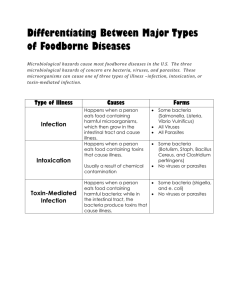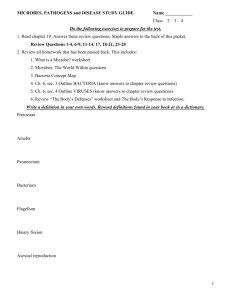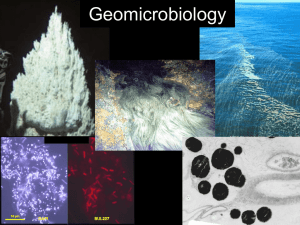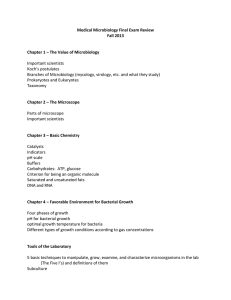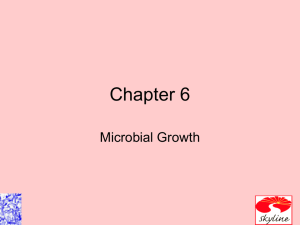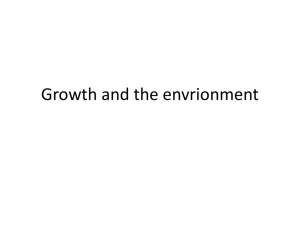Mini-Medical School on Infectious Diseases Session #1 - Basic Science
advertisement
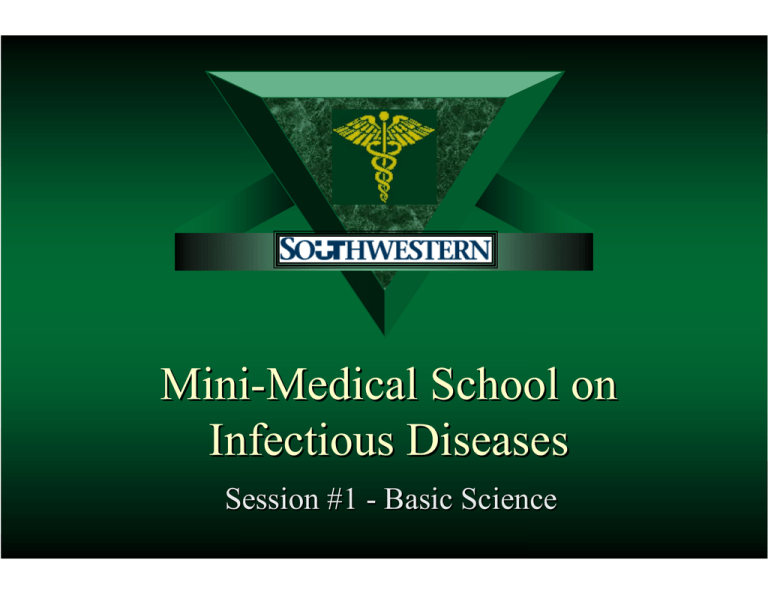
Mini-Medical School on Infectious Diseases Session #1 - Basic Science “The Microbial World” Michael V. Norgard, Ph.D., Chairman Department of Microbiology U.T. Southwestern Medical Center “The Microbial World” Michael V. Norgard, Ph.D., Chairman Department of Microbiology U.T. Southwestern Medical Center Organisms Comprising the Microbial World ✦ Scope of the Problem: – Viruses, bacteria, protozoa, fungi, and parasites – Enormous diversity – Worldwide, more persons succumb to microbial infections than to cancer and heart disease combined. Hierarchy of Microbes: [Smallest → Largest] ✦Viruses ✦Bacteria ✦Single-celled Eukaryotes (animal-like cells): – Parasitic protozoa – Fungi/yeast ✦Higher Eukaryotes: – Parasitic intestinal worms – Tissue worms Distribution ✦Microbes are everywhere and in high numbers. ✦1 gram of human feces contains about 1 trillion bacteria. Common Clinical Ways of Categorizing Microbes ✦“Avirulent” or “nonpathogenic” - harmless. ✦“Virulent” or “pathogenic” - capable of causing disease. Common Clinical Ways of Categorizing Microbes ✦ Normal flora - microbes that colonize the body and usually do not cause disease. ✦ Opportunistic pathogens - microbes that normally do not cause disease, but may under certain circumstances. ✦ Frank pathogens - microbes that always cause disease. ✦ Other - diseases caused mostly by the ingestion of preformed toxins or when toxins are produced from bacteria during infection. Concept of "Pathogenesis" ✦ Pathogenesis - the course of the infectious process. ✦ "Virulence" factors or "pathogenicity" factors – Microbes which can cause disease are thought to carry out the process by utilizing one or more properties called virulence factors or pathogenicity factors. ✦ THE STUDY OF MICROBIAL VIRULENCE FACTORS IS A MAJOR EMPHASIS IN MICROBIOLOGY AND INFECTIOUS DISEASE RESEARCH. ✦ UNDERSTANDING THE MOLECULAR MECHANISMS BY WHICH PATHOGENS EXERT THEIR VIRULENCE PROPERTIES WILL LEAD TO NEW ANTIBIOTICS AND VACCINES. The World from the Microbe's Perspective ✦ Microbes cannot think; they simply exploit the human environment solely for growth and survival. MISSION: SURVIVE AND MULTIPLY TO ENSURE SURVIVAL OF THE SPECIES. Find the Best Place for the Troops to Invade ✦ Concept of Site: Pathogen Combinations – – – – – Staph infection: invasion through compromised skin. Tuberculosis: inhalation into lung. Strep infection: streptococci bind to throat epithelial cells. Urinary tract infection: E. coli enter at urethral orifice. Gastritis: stomach lining acceptable to Helicobacter pylori. Initial Invasion (Infection) ✦ Subtle Infiltration in the Quiet of Night and Often With Camouflage – Streptococcus pyogenes – Streptococcus pneumoniae and Neisseria meningitidis ✦ Massive invasion to overwhelm the opposition – Some of the invaders can escape stomach acid (e.g., E. coli, Salmonella) Establishing a "Beach Head" (Colonization) ✦ Ensuring the availability of food and water (scavenging of nutrients). ✦ Establishing a good defense (armor; barriers) against an offensive (immune) attack. Taking the Offensive (Invasion/Spread) ✦ Moving out from the initial site to more distant sites that offer more territory and more opportunities for survival and expansion. Expand to Neighboring Environments ✦ Infect other individuals. Examples of Microbial Pathogenesis Strategies Viruses ✦ Viruses take over our cells and use them as "factories" to make new virus particles: – Budding - slow release; eventually stresses and kills the cell. – Lysis - rapid, complete destruction of the cell by explosion. – Latent infection - more protracted, insidious infection that may or may not lead to destruction of the infected cell or may lead to cancer. Bacteria ✦ Bacteria exploit a wide spectrum of parasitic strategies. Staph Infections ✦ Staphylococci are part of our normal skin flora but can be highly infectious under appropriate circumstances (e.g., compromised skin). – Principal virulence factors are a combination of potent toxins: • • • • • coagulase (makes fibrin clots on surface of bacterial cell). other enzymes that digest tissue. exfoliative toxin; "scalded skin syndrome." toxic-shock syndrome toxin. enterotoxins; classic "food poisoning." Shigellosis (Bacillary Dysentery) ✦ Toxin - causes severe diarrhea and can affect central nervous system. ✦ Efficient invasion of cells induced by Shigella surface proteins- intracellular residence (a good "hiding" place!). ✦ Spread to adjacent cells via a clever mechanism (without ever leaving its intracellular residence). ✦ Massive tissue inflammation and destruction (blood and pus). Tuberculosis ✦ Mycobacterium tuberculosis enters the lung (via microdroplets). ✦ Also needs to take up an intracellular residence: tricks cells into thinking it is something that should be taken up (coats itself with a host protein). ✦ Chronic, slow-progressing infection for years or decades. Escherichia coli ✦ E. coli - Part of our normal intestinal flora - usually not harmful. – Enteric infections – Urinary tract infection – Sepsis - blood infections. – Meningitis - infection of the central nervous system. Anthrax ✦ Anthrax - actually a disease of farm animals; humans are infected only rarely. However, human infection is very destructive. ✦ Organism: Bacillus anthracis – Cutaneous anthrax (organisms [spores] enter the skin). – Inhalation anthrax (from dust, wool, or debris from hides); has implications for bioterrorism. – A three-component toxin is very potent. Helicobacter pylori ✦ Stomach ulcers from Helicobacter pylori - A huge clinical problem: – Ingestion of organism. – Resistant to stomach acid; bacterium attaches to mucosal epithelial cells. – Organisms are below the mucous layer; they produce ammonia to neutralize stomach acidity. – Organisms create a slow (years to decades) inflammatory response. – Persons with H. pylori gastritis have 3- to 12-fold increased risk of stomach cancer. Parasites ✦ Malaria (several protozoan species of Plasmodium) - transmitted to humans by bite of female Anopheles mosquitoes. – A major global health problem in tropical developing countries. – Plasmodium is a model intracellular parasite - carries out a key part of its life cycle inside the human red blood cell. – Produces enzymes that breakdown hemoglobin of red blood cell as a key nutrient source. – Complex life cycle; partly in humans and partly in mosquitoes. – Phase in humans can be cyclic and thus give rise to relapses over several years. Treatment is difficult and resistance to drug therapy is highly problematic. Hookworm- an Intestinal Roundworm. Life Cycle: Penetrate skin Immature worms Heart and lungs Eggs mature Coughed up Swallowed Eggs in soil Small intestine Eggs excreted Eggs in feces Larvae mature Lay eggs Comparison of Viruses and Bacteria Viruses ✦ Size ✦ Replicate on their own? ✦ Structure Bacteria 10-100 times larger No Simple Yes Complex cell (Genetic material +protein coat only) ✦ Metabolic Functions ✦ Susceptible to classical antibiotics? No No Yes Yes Summary/Take-Home Lessons 1. The “Microbial World”: viruses, bacteria, protozoa, fungi, and other parasites. 2. Microbes are everywhere in the environment; humans are heavily colonized! 3. In humans, there are “avirulent”: (e.g., normal flora which are beneficial) microbes vs. those which are “opportunistic” or “pathogenic.” 4. Sole mission of microbes: Get by and multiply! Summary/Take-Home Lessons 5. Viruses “take over” our cells and use them as “factories” to make new viruses. 6. Bacteria and parasites have evolved highly ingenious strategies to evade our immune responses and to exploit diverse environments within the human body. 7. Bacteria and parasites rely on traits (“virulence factors”) to make them “pathogenic”. 8. Studies of microbial “virulence factors” will provide novel insights for developing new antibiotics and vaccines.
